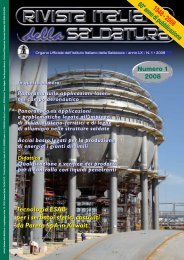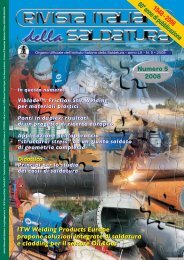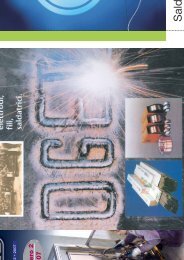Create successful ePaper yourself
Turn your PDF publications into a flip-book with our unique Google optimized e-Paper software.
E. Seib e M. Koçak - Fracture analysis of strength undermatched welds of thin-walled aluminium structures using FITNET procedure<br />
capture the deformation behaviour of<br />
these panels more accurately.<br />
This obviously suggests that the stress<br />
state at the crack tip located in an undermatched<br />
weld is governed by the plane<br />
strain condition (which corresponds to<br />
m = 2.0) despite the fact that the overall<br />
thickness of the thin sheet may suggest<br />
otherwise.<br />
Finally, FITET FFS Procedure offers an<br />
advanced flaw assessment methodology<br />
to the needs of the recent technological<br />
developments in the field of the airframe<br />
fabrication using welded metallic integral<br />
structures. Although, examples are<br />
taken from welded aerospace Al-alloys,<br />
the procedure has a generic nature and is<br />
equally applicable to all welded Alalloys<br />
of 2xxx, 5xxx or 7xxx series<br />
having undermatched welds. Similarly,<br />
high strength thin-walled steel structures<br />
may contain strength undermatched<br />
weld deposits (to have sufficient fracture<br />
toughness and formability).<br />
The FITNET FFS Procedure described<br />
in this paper can also be applied to such<br />
cases.<br />
Acknowledgements<br />
This investigation was conducted within<br />
the collaborative research program with<br />
AIRBUS Hamburg. Authors wish to<br />
acknowledge the valuable contributions<br />
of Dr. H. Assler and Mr. Pacchione and<br />
provision of financial and material<br />
supports to the project.<br />
102 Riv. Ital. Saldatura - n. 1 - Gennaio / Febbraio <strong>2007</strong><br />
[10] ASTM E561: «Standard practice for R-curve determination», Annual book of<br />
ASTM standards, Vol. 03.01, 1994.<br />
[11] Schwalbe K.H.: «Introduction of δ5 as an operational definition of the<br />
CTOD and its practical use», Fracture Mechanics, ASTM STP 1236, 1995,<br />
pp. 763-778.<br />
[12] Tada H., Paris P.C., Irwin G.R.: «The stress analysis of crack handbook»,<br />
New York: ASME Press, 3 rd edition, 2000.<br />
[13] Koçak M., Seib E., Motarjemi A.: «Improvements to the fracture assessment<br />
of welds using FITNET fitness for service assessment procedure». In:<br />
Proceedings of the 24th International Conference on Offshore Mechanics and<br />
Arctic Engineering (OMAE), Halkidiki, Greece, 12-17 June, 2005.<br />
Seminario Europeo<br />
sulla saldatura delle rotaie ferroviarie<br />
Cambridge 24.01.<strong>2007</strong><br />
Il giorno 24 Gennaio si è svolto, presso il “The Welding<br />
Institute” di Cambridge (UK), il Seminario Europeo<br />
“Education, training, qualification and certification of railway<br />
track welders on a common European basis”. Tale<br />
Seminario si è tenuto nell’ambito delle attività sviluppate dal<br />
progetto di Formazione professionale europea Leonardo da<br />
Vinci “Railsafe”.<br />
Il Seminario è stato seguito da circa quaranta partecipanti<br />
provenienti dagli Enti ferroviari europei, Imprese operanti nel<br />
settore dell’armamento ferroviario, Società produttrici di<br />
materiali e attrezzature per la saldatura delle rotaie, nonchè<br />
dagli Istituti nazionali della Saldatura ed aveva lo scopo di<br />
informare sullo stato di esecuzione del progetto stesso,<br />
aggiustandone, se del caso, gli indirizzi. In particolare sono<br />
stati espressi utili commenti e suggerimenti da parte dei due<br />
delegati ufficialmente inviati al Seminario dal Comitato di<br />
normazione CEN TC256/SC1/WG4 che, nello specifico, si<br />
occupa dei diversi aspetti tecnici concernenti la realizzazione<br />
dei binari ferroviari.<br />
Anche in virtù di tali commenti verranno specificate meglio le<br />
differenze tra diploma e certificati, verrà ulteriormente<br />
implementata la procedura descrittiva del procedimento di<br />
saldatura alluminotermico nelle sue diverse varianti e<br />
modificato il database per la gestione dei saldatori e dei<br />
certificati a livello europeo, adattandolo meglio alle necessità<br />
delle varie Autorità (Enti) ferroviari nazionali.<br />
Per informazioni: Istituto Italiano della Saldatura<br />
Ing. Carlo Rosellini; Responsabile Settore Ricerca<br />
Tel. 010 8341 318 – carlo.rosellini @iis.it





